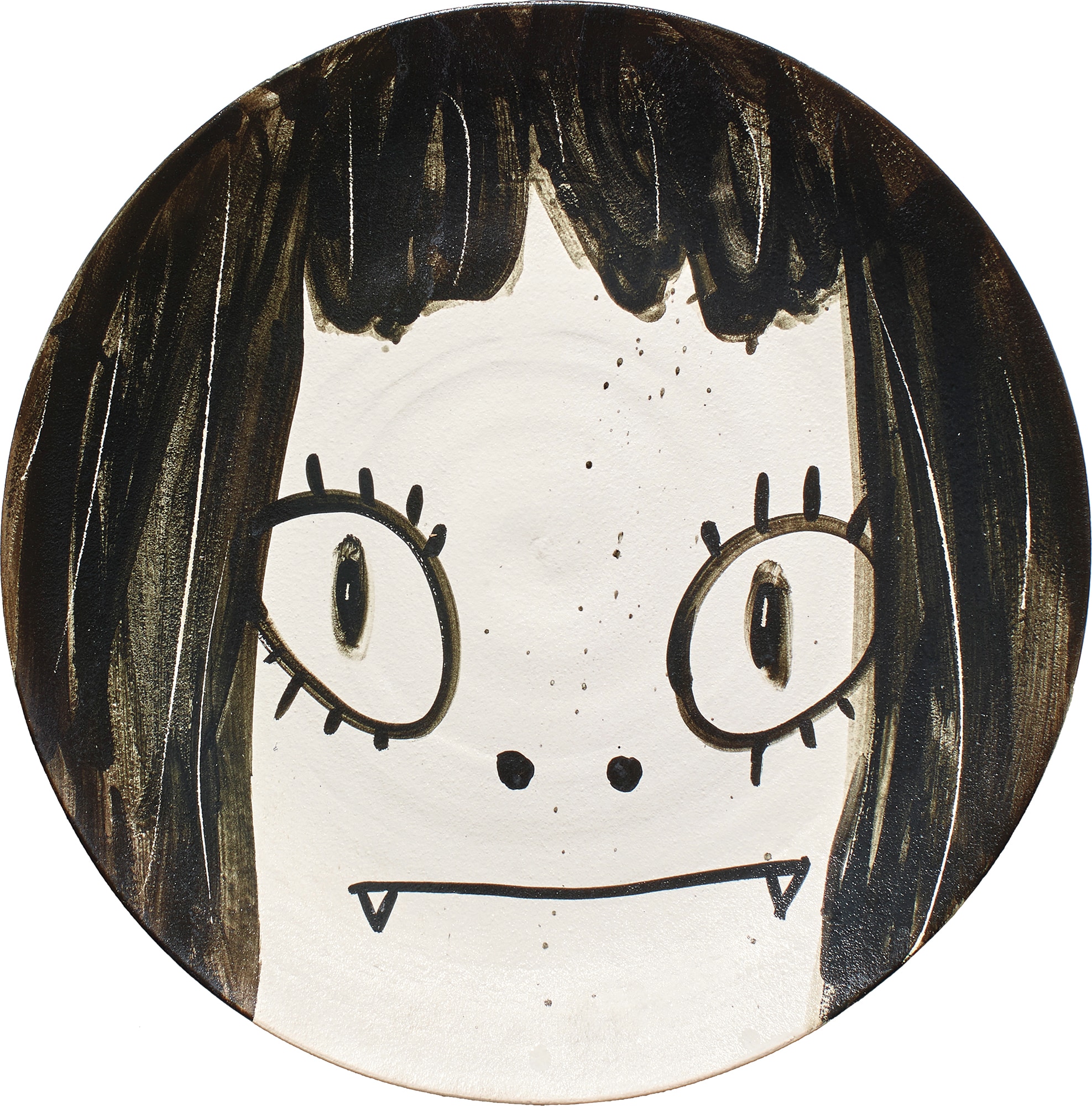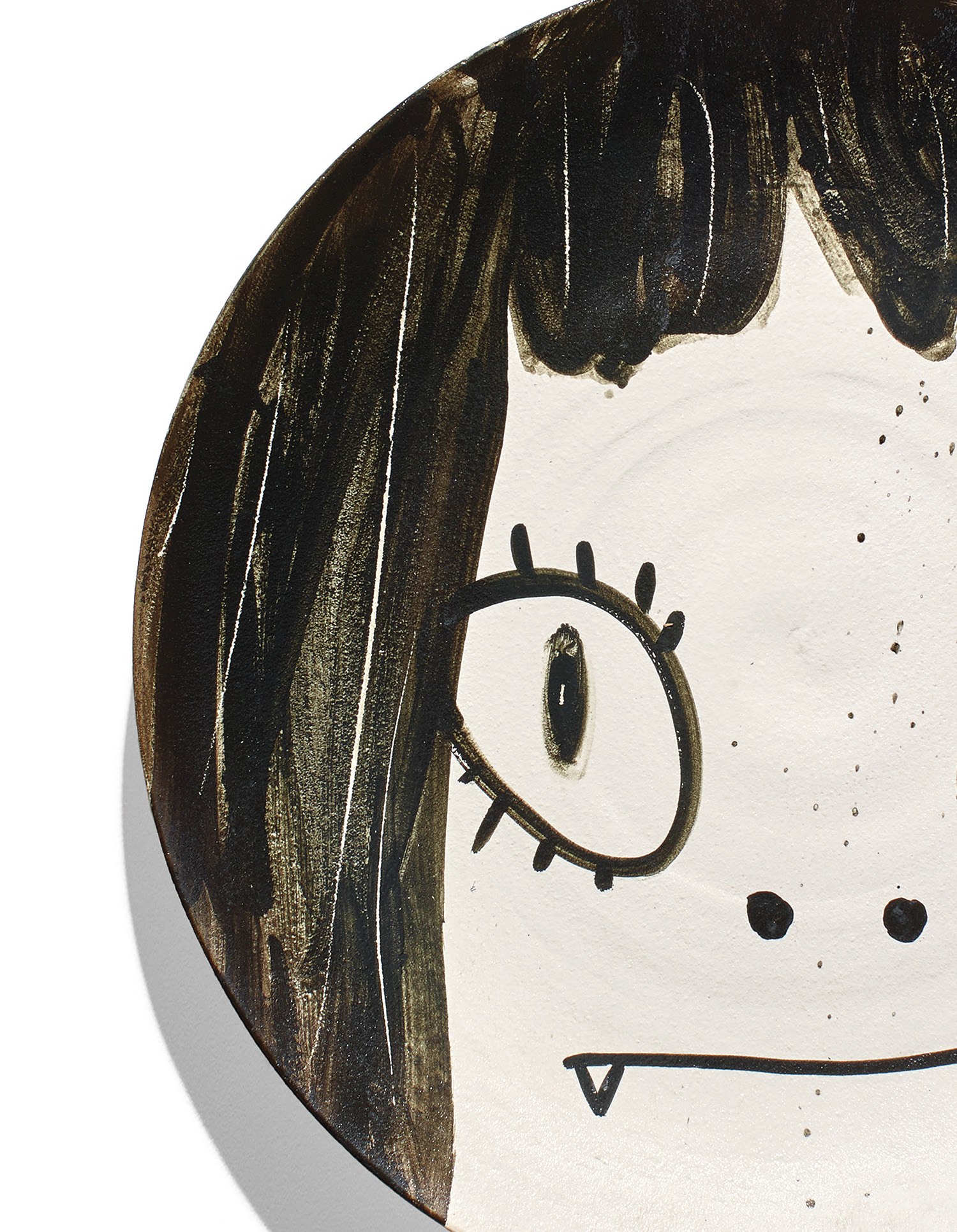



56
Yoshitomo Nara
Untitled
glazed ceramic
diameter 77 cm (30 3/8 in.)
depth 8.5 cm (3 3/8 in.)
depth 8.5 cm (3 3/8 in.)
Executed in 2007.
Full-Cataloguing
Executed in 2007, Untitled by Yoshitomo Nara is a rare example from the artist’s multifaceted oeuvre, one of circa thirty ceramic plates executed by the artist in that year. Featuring Nara’s motif of a little girl, here seen in the guise of a vampire, the present work showcases Nara’s evocative rendering of his young character, conveyed through the medium of clay. Conjuring a visual dialogue with the exceptionally early and prolific Japanese pottery tradition, Nara grew up during a period of westernisation in Japan and was influenced by punk music, comic books and television as well as traditional art forms; his work offers a nuanced symbiosis of popular culture and the ancient medium of clay. As exemplified in the present work, Nara masterfully captures the spirit of his ambiguous character, exquisitely crafted through his skilful balance of form, glaze application and line.
Created ten years prior to Nara’s retrospective at the Toyota Municipal Museum of Art, Aichi, Nara’s craftsmanship was recently celebrated at his 2018 exhibition at Pace gallery’s inaugural Hong Kong space, offering an insight into his recent ceramic output. In the same way that the inside concave plane of the plate in the present work is wholly covered by the face of Nara’s young girl, so his recent sculptures showcase monumental ceramic heads, displaying only the visage and, often exaggerated, heads of his fictional characters. All-consuming and grand in scale, Nara’s new ceramic works engulf us, subsuming the viewer into his complete celebration of the medium. Fascinated by clay’s malleable properties, Nara’s absorption into his ceramic practice is evident, whether sculpting the clay into a figurative realisation of his character or using glaze to paint the outline of its manga-like face. Nara’s work celebrates the ancient properties of these organic materials, unveiling the skill necessary to produce hand painted plates and to hand build with clay, his large heads remindful of Haniwa warriors from the Kofun period. Consumed by the intuitive properties of crafting from clay, Nara asserts ‘I couldn’t make pictures on a blank canvas, but I found I could confront a mass of clay, I wouldn’t think about it with my mind. I would just attack it, like in sumo, with my body’ (Edan Corkill, ‘Yoshitomo Nara puts the heart back in art’, The Japan Times, 20 July 2012, online).
Bearing the same cyclical format as many of the artist’s paintings, the present work solely focuses on the countenance of Nara’s little character. With her broad forehead, bright eyes and straight mouth, Nara’s figure bears a small pair of fangs. Sometimes comical, violent, whimsical or macabre, the artist’s protagonists often look isolated in their lonely microcosms, evoking childlike wilfulness and a sense of independent freedom. ‘His work attracts many people, because they recognise their precious inner solitude within it, a solitude which has often been long lost’ (Banana Yoshimoto, ‘The World of Nara-kun’, Yoshitomo Nara. Complete Works, San Francisco, 2011, p. 9). Harnessing the impulsive and reactionary immediacy of childhood, Nara’s choice of medium captures every finger mark and movement applied to the clay, making it truly representative of energy and motion. While on a recent residency in a small town in Hokkaido, Nara was based at a disused school and noted, ‘While I was adding water to the clay, some children came in exploring and they started to collaborate with me very spontaneously to make the work. I was very inspired and moved to see children coming back to a disused school and gradually they worked with me on making the face of a child from the clay’ (Romina Provenzi, ‘Yoshitomo Nara’s Lessons in Clay’, Elephant, 17 August 2018, online).
Whereas Nara’s canvases are often layered with translucent layers of paint, built up to hide the raw canvas below, in Nara’s ceramic work the properties of the medium are not only clearly evident, but cherished by the artist, showcased as an integral element of the work’s design, as evident in the present work. Speaking in regards to his latest body of ceramic works, Nara states:
‘Drawings have always sustained me as an artist whenever my painting process wasn’t going well, but since I first took the medium of clay in my hands about 10 years ago, it’s become something that lies right between painting and drawing for me. In particular, the positive surrender to taking a clay work that I believe is creatively complete, and seeing it replaced by the fired ceramic result which may be better or worse than my own capabilities, feels good. I think it’s because it differs from other sculptural media that can be controlled, but my encounter with creating ceramics has been one of the most significant of my artistic life.
Recently I realized that clay is freer than pencil. Before a toddler first grasps a pencil and draws, comes the act of holding. Change comes about from holding, squeezing, releasing, holding again. This is a more primal instinct to create with the hands directly, rather than using a tool like a pencil or a brush. … I believe that my artistic consciousness (or rather, my personal consciousness), which has long been sustained by drawing whenever painting did not come easily, has grown a little from gaining the output of ceramics’ (Yoshitomo Nara, ‘Ceramic Sculptures and Drawing and Painting’, in Press Release, Ceramic Sculptures and Drawing and Painting, Pace Gallery, Hong Kong, 2018, online).
Created ten years prior to Nara’s retrospective at the Toyota Municipal Museum of Art, Aichi, Nara’s craftsmanship was recently celebrated at his 2018 exhibition at Pace gallery’s inaugural Hong Kong space, offering an insight into his recent ceramic output. In the same way that the inside concave plane of the plate in the present work is wholly covered by the face of Nara’s young girl, so his recent sculptures showcase monumental ceramic heads, displaying only the visage and, often exaggerated, heads of his fictional characters. All-consuming and grand in scale, Nara’s new ceramic works engulf us, subsuming the viewer into his complete celebration of the medium. Fascinated by clay’s malleable properties, Nara’s absorption into his ceramic practice is evident, whether sculpting the clay into a figurative realisation of his character or using glaze to paint the outline of its manga-like face. Nara’s work celebrates the ancient properties of these organic materials, unveiling the skill necessary to produce hand painted plates and to hand build with clay, his large heads remindful of Haniwa warriors from the Kofun period. Consumed by the intuitive properties of crafting from clay, Nara asserts ‘I couldn’t make pictures on a blank canvas, but I found I could confront a mass of clay, I wouldn’t think about it with my mind. I would just attack it, like in sumo, with my body’ (Edan Corkill, ‘Yoshitomo Nara puts the heart back in art’, The Japan Times, 20 July 2012, online).
Bearing the same cyclical format as many of the artist’s paintings, the present work solely focuses on the countenance of Nara’s little character. With her broad forehead, bright eyes and straight mouth, Nara’s figure bears a small pair of fangs. Sometimes comical, violent, whimsical or macabre, the artist’s protagonists often look isolated in their lonely microcosms, evoking childlike wilfulness and a sense of independent freedom. ‘His work attracts many people, because they recognise their precious inner solitude within it, a solitude which has often been long lost’ (Banana Yoshimoto, ‘The World of Nara-kun’, Yoshitomo Nara. Complete Works, San Francisco, 2011, p. 9). Harnessing the impulsive and reactionary immediacy of childhood, Nara’s choice of medium captures every finger mark and movement applied to the clay, making it truly representative of energy and motion. While on a recent residency in a small town in Hokkaido, Nara was based at a disused school and noted, ‘While I was adding water to the clay, some children came in exploring and they started to collaborate with me very spontaneously to make the work. I was very inspired and moved to see children coming back to a disused school and gradually they worked with me on making the face of a child from the clay’ (Romina Provenzi, ‘Yoshitomo Nara’s Lessons in Clay’, Elephant, 17 August 2018, online).
Whereas Nara’s canvases are often layered with translucent layers of paint, built up to hide the raw canvas below, in Nara’s ceramic work the properties of the medium are not only clearly evident, but cherished by the artist, showcased as an integral element of the work’s design, as evident in the present work. Speaking in regards to his latest body of ceramic works, Nara states:
‘Drawings have always sustained me as an artist whenever my painting process wasn’t going well, but since I first took the medium of clay in my hands about 10 years ago, it’s become something that lies right between painting and drawing for me. In particular, the positive surrender to taking a clay work that I believe is creatively complete, and seeing it replaced by the fired ceramic result which may be better or worse than my own capabilities, feels good. I think it’s because it differs from other sculptural media that can be controlled, but my encounter with creating ceramics has been one of the most significant of my artistic life.
Recently I realized that clay is freer than pencil. Before a toddler first grasps a pencil and draws, comes the act of holding. Change comes about from holding, squeezing, releasing, holding again. This is a more primal instinct to create with the hands directly, rather than using a tool like a pencil or a brush. … I believe that my artistic consciousness (or rather, my personal consciousness), which has long been sustained by drawing whenever painting did not come easily, has grown a little from gaining the output of ceramics’ (Yoshitomo Nara, ‘Ceramic Sculptures and Drawing and Painting’, in Press Release, Ceramic Sculptures and Drawing and Painting, Pace Gallery, Hong Kong, 2018, online).